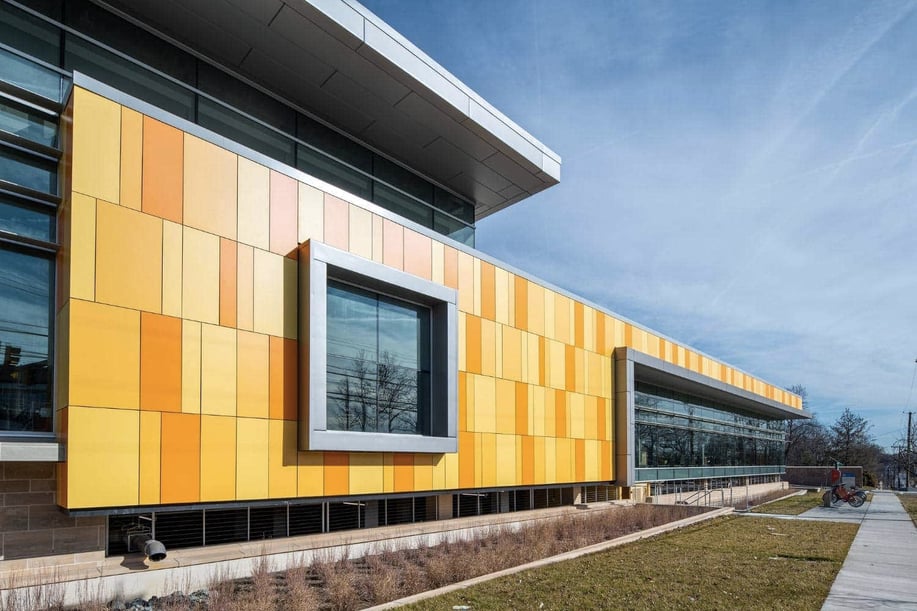
How to Clean High-Pressure Laminate Panels
| Last updated August 26, 2025
High-pressure laminate panels, also called HPL panels or phenolic panels, are made for ultimate durability. The raw materials and manufacturing process result in an architectural panel that is not only durable, but also eco-friendly and extremely easy to clean and maintain.
With over a century of experience and a reputation for excellence among phenolic panel manufacturers, Fundermax is pleased to share our expertise about when to use and how to clean HPL panels.
Common Phenolic Panel Uses
The benefits of phenolic panels, which we will discuss more specifically below, make phenolic cladding an exciting option for a number of exterior and interior uses including:
Exterior
-
rainscreen façades
-
soffits
-
balconies
-
signage
Interior
-
wall lining
-
bathroom partitions
-
lockers
-
lab work surfaces
-
furniture
Benefits of Phenolic Panels
Phenolic panels are made by sandwiching multiple core layers of kraft paper between an exterior layer of décor papers. Before stacking, the core layers are saturated with thermosetting phenolic resin; then, when the stack is pressed under high heat and pressure, the thermosetting creates irreversible bonds resulting in a nonporous, homogeneous board that offers aesthetic appeal and exceptional durability with minimal maintenance.
Aesthetic Appeal
Phenolic cladding panels are manufactured in a wide variety of colors and finishes; when combined with the inherent integrity and colorfastness of HPL, architects and designers realize not only a technical advantage but a creative advantage as well.
Exceptional Durability
A high-quality phenolic wall panel system can be installed virtually anywhere because of its ability to withstand exposure to both high traffic and harsh weather. Here again, we see the extraordinary combination of physical durability and long-lasting aesthetics.
Minimal Maintenance
In addition to the technical and creative advantages, phenolic cladding panels also offer an ease of care with minimal maintenance equating to lower lifetime cost of ownership. Periodically cleaning wall cladding (and cleaning phenolic panels in other applications as well, such as washroom partitions and work surfaces) will understandably be part of the material’s regular – be it minimal – maintenance.

How to Clean Wall Cladding: An Overview
The three methods most commonly used for cleaning wall cladding are:
-
water, including self-cleaning by rainwater
-
chemicals
-
abrasive treatments
Thanks to phenolic cladding panels being nonporous, when fungus, dirt, and dust particles make their way onto the panel surface, it can typically be removed by rinsing with water. One important note specifically regarding how to clean exterior wall panels is that rainwater serves as a self-cleaning method for an exterior phenolic wall panel system! (This, in contrast to a highly porous surface that must be cleaned using abrasive treatments like sanding, grinding, or blasting as even the most common dust or fungus strongly adheres.)
What about stains or graffiti that water alone cannot remove? Again, unlike porous materials, since HPL panels are nonporous, those of the highest quality (like Fundermax panels) can tolerate harsh solvents like acetone without damaging the panel. (Manufacturer specifications should always be referenced for precise details.) Abrasive-coated scouring pads and powders should not be used on phenolic panels, however, as they may permanently scratch or dull the HPL surface.
How to Clean Phenolic Panels: The Specifics
Cleaning wall cladding can be accomplished in 2 to 7 simple steps, depending on the stubbornness of the dirt or stain. The following are simple instructions for how to clean Fundermax panels easily and thoroughly.
Step 1: Basic Supplies
The following supplies will be sufficient to regularly clean HPL panels.
-
Warm water
-
Gloves
-
Soft Cloths
-
Dry erase pads
If the above supplies have sufficiently cleaned the area in question, proceed to step 7.
Step 2: Glass Cleaner
Use a common household glass cleaner, if needed.*
Step 3: Green Soap
Progress to applying green soap in a 1:3 ratio, if needed.*
Step 4: Acetone
Progress to using acetone for persistent stains or vandalism.*
Step 5: Adhesive Remover
Apply an adhesive remover, if necessary.*
Step 6: Vinegar
To remove other stubborn stains or remaining dirt, use vinegar (Acetic Acid 10%).*
Step 7: Rinse
Lastly, rinse with warm, clean water. You may also wipe down the surface with a soft, clean, dry cloth.
*Remember that Fundermax produces high-quality phenolic resin panels which may offer greater chemical resistance than other phenolic panel manufacturers’ products. Be sure to check the specific instructions for how to clean phenolic panels from another manufacturer if needed.
Phenolic cladding panels are a high-design architectural solution that is user-friendly & cost-effective. Reach out to us today to discuss if Fundermax interior or exterior phenolic wall panels may be the right fit for your next project.

